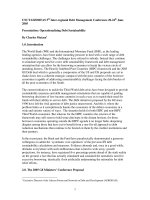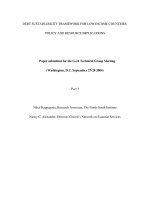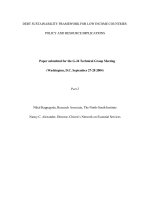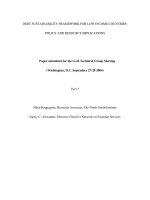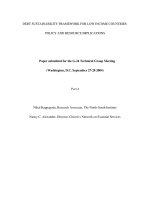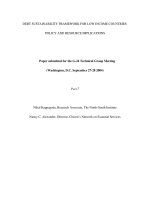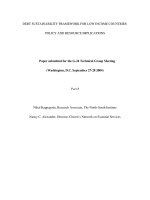Operationalizing Debt Sustainability
Bạn đang xem bản rút gọn của tài liệu. Xem và tải ngay bản đầy đủ của tài liệu tại đây (82.83 KB, 12 trang )
UNCTAD/DMFAS 5
th
Inter-regional Debt Management Conference 20-24
th
June
2005
Presentation: Operationalizing Debt Sustainability
By Charles Mutasa
1
1.0. Introduction
The World Bank (WB) and the International Monetary Fund (IMF), as the leading
lending agencies, have been under mounting pressure to deal with a wide range of debt
sustainability challenges. The challenges have refused to subside. Instead they continue
to stimulate urgent need for a new debt sustainability framework and debt management
orientation that can allow for the borrowing economies to break the vicious circle of
unending distress. The Heavily Indebted Poor Countries (HIPC) framework and the 2005
G8 Debt deal which is generally a compromise of the US and UK proposals are yet to
shake down into a coherent strategic compact (with the poor countries of the borrower
economies) capable of addressing unsustainability challenges facing the debt burden of
all the poor economies of the South.
The current initiatives to tackle the Third World debt crisis have been designed to provide
sustainability measures and debt management orientations that are capable of guiding
borrowing decisions of low-income countries in such a way as to match their need for
funds with their ability to service debt. The Debt initiatives proposed by the G8 since
1996 have left the vital question of debt justice unanswered. And this is where the
problem hides as it surreptitiously haunts the economies of the debtor economies in a
wide and sinister variety of ways. The situation holds for both HIPC and non-HIPC
Third World economies. But whereas for the HIPC countries the exterior of the
framework may still seem to hold some dim hope in the distant horizon, for those
borrower economies operating outside the HIPC agenda it no longer hides deepening
disquiet among those that have yet to benefit from a one-fits-all approach to debt
reduction mechanisms that continue to be foisted on them by the creditor institutions and
their partners.
In the recent past; the Bank and the Fund have paradoxically demonstrated a generous
willingness to admit the ‘systematic over-optimism’ of the previous IFI debt
sustainability calculations and measures. Evidence abounds and, once in a good while,
obtrudes everywhere with such stubbornness that is hard to wish away: growth
projections, for instance, have registered five percentage points ahead of the stark reality
on the ground; a fact that has actually stimulated and sustained the unrealistic need for
excessive borrowing: drastically if not artificially undermining the rationality for debt
relief efforts.
2.0. The 2005 G8 Ministers’ Conference Proposal
1
Executive Director of the African Forum and Network on Debt and Development (AFRODAD).
1
While the G-8 agreement is a step forward and sets an important precedent we have long
advocated for a 100% unconditional cancellation of debt to all severely indebted poor
countries. The deal only represents one eighth of what Africa needs in terms of Debt
cancellation, as this means canceling only US $40 billion out of Africa’s burgeoning debt
stock of over US$330 billion.
The $40 billion to be cancelled represents less than 10% of
debt cancellation required for poor nations to meet the MDGs. The plan does not include
middle-income countries that are heavily indebted and impoverished
.
The G-8 Deal
includes too few countries. Globally, the 18 countries that qualify immediately represent
less than a third of countries (at least 62) that need full cancellation to meet the
internationally agreed Millennium Development Goals (MDGs), which seek to halve
extreme poverty by 2015.
Choosing 18 countries that have reached the HIPC completion point (14 of which are in
Africa) to benefit from the deal is in itself a sign that debt cancellation is been treated as a
question of charity and not global justice. The agreement does not address the real global
power imbalances but rather reinforces global apartheid. The question of creditor –debtor
co-responsibility of the South‘s debt remains unresolved, as issues of odious and
illegitimate debts continue to be swept under the carpet. It is not a lasting solution in
which all stakeholders-debtors and creditors have a say. It is just a piecemeal measure
that seems to deal with the symptoms of the problems and not the causes.
Conditionalities still remain a big deterrent to economic emancipation of the poor
countries chosen to benefit from the deal. The economic policies mandated by the HIPC
Initiative will continue under the G-8 debt deal, including privatization of government-
run services and industries, increased trade liberalization, and budgetary spending
restrictions. These policies have not been proven to increase per capita income growth or
reduce poverty as documented by both World Bank and civil society economists. The
best way to resolve the Debt crisis must be within an international framework in which
both the Creditors and Debtors have an equal say. Continuous monopoly by rich
countries to tell us the best way out of the Debt and poverty vicious cycle is the greatest
shortfall in global economic justice. The G8 deal does not address the moral hazards and
perverse incentives inherent in the debt relationship. Unfortunately and regrettably the
deal is not premised on the understanding of the historical loan contraction and debt
management problems inherent in the developing world and is likely to result in the
recurrence/exacerbation of the debt crisis.
3.0. The viable option: Debt Cancellation
One major reason why the ongoing discussions about multilateral debt cancellation has
not yet produced concrete results is that there is no agreement about the best way to fund
the debt cancellation. We feel that the funding for debt cancellation should be evaluated
in a tiered manner; the most desirable and least controversial source of funding being
exhausted before the next tier is mobilized.
The first tier, which is both additional and does not require higher aid budgets, is the sale
of IMF gold. The second tier is additional contributions by creditor countries as
suggested in the current UK debt relief proposal. Together, these two sources of funds
2
should generate enough resources to allow 100% cancellation multilateral debt for a
number of the poorest countries in the world. If there is a requirement for residual funds,
we believe as civil society that there exists a third tier of funds: The (IBRD) International
Bank for Reconstruction and Development that can generate more resources without any
significant impact on its operations.
This tiered approach lies at the heart of the civil society proposal for Debt Sustainability
in LDCs especially in Africa. In many ways, this proposal builds on aspects of the other
two proposals presented by the UK and the US governments respectively and is
complementary to them. The proposal also serves as a compromise between the
otherwise incompatible positions of the US and UK proposals by offering a way of
tapping multilateral resources (US proposal) in a way that they are new and additional
(UK proposal).
4.0. Fair and Transparent Arbitration Mechanism
Realizing the recurring nature of indebtedness and the fact that the HIPC debt relief
initiative has not dealt with the problem of external debt comprehensively, (which often
worsens instead as has been the case in country after country) debt campaigners, while
calling for 100% multilateral debt cancellation have also simultaneously advocated for a
systemic resolution to the problems of un-payable sovereign debt. This is embodied in the
Fair and Transparent Arbitration mechanism which seeks to enshrine the superiority of
basic human rights, ascertain the legitimacy of creditor claims to deal with the issues of
odious debt and give the affected people a right to be heard.
Fair and Transparent Arbitration mechanism will deal with cases of illegitimate and
odious debts as well as the repatriation of stolen wealth to the debt stricken nations of
Africa. For example in the DRC evidence has been presented that the official creditors
and private creditors of the Mobuto regime knew, or should have known, there was a
high risk that their loans, or a substantial part of them would not be used to benefit the
people of the DRC.
One way of looking at resolving the third world debts would be by first securing an
agreement on the working definition of debt sustainability. This implies revisiting the
concept of debt sustainability as given by the HIPC initiative, identifying its short-falls
and seeking ways of redressing them so as to enable the initiative to work better for the
poor countries. The issues of both domestic and external debt as well as the role of
shocks in the fiscal and monetary policies of the poor country become very important.
5.0. Definition of Key terms
Debts are only considered ‘sustainable’ when the debt service burden leaves the HIPCs
with sufficient funds to meet their human rights obligations under the internationally
agreed Millennium Development Goals (MDGs). Under the enhanced HIPC initiative,
debt to export ratio and the ratio of Debt service to Exports has been used as criteria for
debt sustainability calculations.
3
The mostly used indicators of external debt sustainability are the ratio of exports earnings
to the net present value of all future debt servicing payments. Levels of 20 to 25 percent
(ratio of export to GDP) and 150 to 200 percent (NPV debt/revenue) of these indicators
have been considered as benchmarks. If these ratios were exceeded, the country would be
facing imminent debt services problems. In line with such a definition, Kenya is among
four poor countries (others are: Angola, Yemen and Vietnam) classified as having
sustainable debt levels. This has denied it access to debt relief at a time when the country
is experiencing a net outflow of resources over the past several years. The main
contributor to these outflows is the heavy debt service burden.
Some academics have argued that Kenya is officially on the HIPC initiative list, but is
considered to already have a sustainable debt burden according to the official HIPC
initiative criteria. Debt is considered sustainable when the ratio of the Net Present Value
(NPV) of debt to export is more than 150%, or when the NPV of debt to revenues is more
than 250%. Since Kenya has an NPV of debt-to- export ratio of ‘only’ 148%, it is
considered potentially sustainable. Put that aside, one is tempted to believe that, it is
possible that Kenya’s exclusion from receiving any benefit under the HIPC initiative has
been due to concerns about governance in the country, particularly under the former
president Daniel Arap Moi.
Recently a fiscal indicator was introduced as a measure of debt sustainability. This is the
ratio of debt stock as a percentage of domestically generated revenues the benchmark is
between 250 to 275 percent. However, these are not only the indicators, as there are other
factors that should be considered. These other factors range from a country’s fiscal and
foreign exchange reserve positions, the efficiency of foreign exchange markets, the pace
and variability of exports and future financing gaps and the creditworthiness of the
country.
Kenya’s case highlights the narrowness of the HIPC debt sustainability criteria that
compares external debt to exports. In reality; Kenya’s problem lies not only in the
external debt, but also in the internal debt. The amount of Kenyan internal debt reached
$3.1 billion in 2002, bringing the total level of public debt to $7.97 billion, almost 70% of
the country’s GDP. Since internal-debt service accounts for 13% of government
expenditure, we believe it should be taken into consideration.
2
Kenya’s Debt
sustainability is not enough to help it attain the Millennium Development Goals by 2015.
The country’s Debt sustainability has the potential of been undermined by the HIV/AIDS
pandemic.
6.0. The HIPC Initiative
Many development agencies and skeptics have already pointed out the Heavily Indebted
Poor Countries Initiative (HIPC) launched in 1996 and its successor the Enhanced
Heavily Indebted Poor Countries Initiative (EHIPC)‘s inability to achieve the promised
objective of a “robust exit from the burden of unsustainable debts” for developing
2 Jubilee2000 Research, November 2003, />
4
countries. Problems associated with the design and implementation of the initiative
suggest that neither of the two HIPC versions has succeeded in providing adequate
response to the Third World ’s debt overhang. An analysis of key debt indicators shows
that external debt and debt-servicing problems are most severe and persistent in the
heavily indebted poor countries (HIPCs), the target group of the HIPC Initiative.
Throughout the process, creditors failed to put sufficient political will, resources and
serious analysis into the debt reduction operations. Debt reduction targets were set and
reset arbitrarily - writing off 30 percent, then 50 percent, and so on-rather than based on
serious assessments of the needs of each country. Despite the IMF estimates and claims
through HIPC that Africa's debt service payments would only go as low as 17.1 percent
of export earnings in 2001 (down from 20.3 percent in 1999, before rising again to 18.4
percent in 2002. This remained a mirage. The process has been much slower than
expected and the initiative is suffering from problems of under funding, excessive
conditionality, and restrictions over eligibility, inadequate debt relief and cumbersome
procedures.
The HIPC initiative’s focus on purely economic criteria in assessing a country's debt
burden betrays an utter lack of concern for human development and for the capacity of
poor countries to meet the needs of their own people.
The socio-economic gains made as
a result of enhanced debt relief are by no means universal and, where they exist, they are
limited and precarious. The reason for such a significant discrepancy between the
Enhanced HIPC Initiative projected and actual present values of Sub-Saharan Africa’s
debt to exports ratios include the fact that the projections were based on economic
assumptions that were too optimistic. There was also a sharp decline in the prices of the
commodities they export
Basically, there are three main criticisms to HIPC-the first one is its “limited and narrow”
criteria based on exports. Second is the primacy of debt and debt repayment. On this
NGOS have been arguing for an alternative debt sustainability analysis based on the idea
that the fulfillment of human development needs should come first and then the service of
debt. The third criticism is that the creditors do not only do analysis but also monopolize
decision-making prescribing solutions to the debt crisis. In a nutshell, the Bank and the
IMF are playing the role of judge and jury in this debt sustainability question.
7.0. Operationalizing Debt sustainability
In order to operationalize debt sustainability existing frameworks such as HIPC and the
recently announced Country institutional Policy Assessment (CPIA) need a revisit. This
is necessary in order to address the shortfalls of existing debt sustainability frameworks.
A number of key issues in the HIPC initiative need to be addressed:
External shocks: Shocks have an impact on the size of the primary surplus. Examples of
shocks are rise in the price of oil, high currency depreciation, rise in domestic interest
rates famine, fall in prices of primary products, decline in rate of economic growth, and a
dramatic fall in foreign financing, and other contingencies
5
